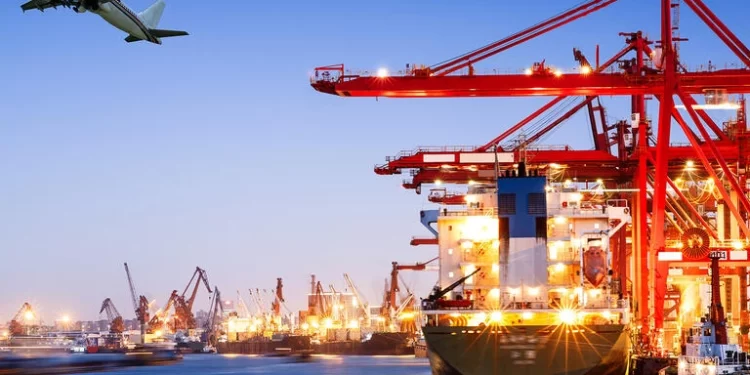Despite the recent slowdown caused by the Covid-19 pandemic and ongoing supply chain disruptions, the global transport and logistics sector market is set to grow robustly from around $8tn in 2020 to around $12.8tn in 2025, according to a report by strategy& titled, ‘Modernizing Gulf Logistics Through Digitization’.
The report attributes the growth to an increase in global trade activities and commodity exports from developing economies, more global and regional trade-related agreements, the expansion of e-commerce, investments in logistics infrastructure around the world, technological advances, and the enabling and efficiency effects of digitisation on logistics.
Technology, in particular, has had the most compelling impact on logistics and supply chain. Dr Shereen Nassar, global director of Logistics Studies, Edinburgh Business School, Heriot-Watt University Dubai, says: “The internet of things (IoT) has been one such impactful technology that has revolutionised many industries. It has helped companies become more agile and efficient. Cloud technology and mobile computing have also been beneficial for the sector and changed aspects such as planning, sourcing and distribution. Cloud-based solutions can also minimise cost and provide real-time data on various parts of the supply chain journey.”
Smart-analytics-powered dashboards, on the other hand, are helping global businesses gain visibility over third party logistics, or 3PL, operations and their own fleet performance. Data analytics aggregate delivery KPIs to improve decision making and help identify optimisation opportunities. Artificial intelligence (AI) though remains one of the biggest trends that has benefitted the supply chain industry.
“It is helping supply chain stakeholders build self-governing and sustainable logistics processes, while predictive intelligence is allowing businesses to build proactive logistics networks by gaining critical insights into delays, exceptions and emergencies,” says Soham Chokshi, CEO and co-founder of Shipsy, a logistics software solutions provider. “On the other hand, blockchain enables businesses to drive high levels of trust, transparency and financial traceability across supply chain networks,” he adds.
Robust market
The UAE, which ranks 11th globally in the World Bank’s Logistics Performance Index, is focused on adopting technological advancements to tackle demand and supply, sustainability issues and growth. Amadou Diallo, CEO of DHL Global Forwarding, Middle East and Africa, says, “The UAE has always been a key market for us, as it continues to invest in infrastructure and road capabilities to meet the growing demand for global trade.
The country is also witnessing a boom in e-commerce, as is the region.” According to Statista, the e-commerce market in the GCC is booming, expected to grow from $24bn in 2020, to reach $50bn by 2025.
Diallo says the increasing demand has put enormous pressure on logistics providers “to automate their operations to reduce labour-intensive processes via technology investments and the incorporation of workforce flexibility. We are leveraging technology to provide customers with more accessible tools to manage shipments and supply chains”.
Automated storage and retrieval systems have been key to help find, pick and move inventory around to help companies meet the tight delivery deadlines that are associated with e-commerce. Companies such as Aramex have also rolled out technological solutions to improve accuracy in pick-up and delivery.
“We have partnered with what3words to further boost the last-mile service with an improved and accurate address system. The integration supports regional SMEs who are looking to optimise customer experiences and offer better customer service,” says Alaa Saoudi, COO at Aramex.
Robotics and drones
Robotic solutions are also game-changers, says Diallo. “Increasing automation will drive the use of robotic solutions in warehouses, which will result in enormous time and monetary savings for businesses.”
Companies are also looking to use autonomous drones for warehouse inventory management. dnata is one of them. The company is planning to launch them at its warehouses at Dubai International Airport and Dubai World Central. The drones aim to digitise acceptance and warehouse inventory processes by monitoring shipment with up to 99.8 per cent accuracy. They are paired with a tablet and provide live inventory data.
The collected data can be viewed directly on the tablet or via an app. Guillaume Crozier, senior vice president, dnata, says: “Our partner’s innovative software enables the drones to map the environment, collect inventory data, count cases, measure temperature and read barcodes using only their cameras, without the need for any additional active infrastructure.” The company is also working on a next-generation e-commerce system.
Crozier adds, “Customers will be able to integrate the platform into existing workflows through APIs (application programming interfaces) and take advantage of all innovative functions while using their own system. The platform will also help customers simplify existing processes, without investing in multiple systems. Furthermore, it will enhance sustainability by promoting paperless and cashless trade through collaboration and automation.”
Companies of all sizes – from e-commerce sites and SMEs to shippers, couriers and delivery services – can benefit from using logistics APIs. The APIs can be used to drive business agility and enhance customer experience, among other functions. Henrik Ambak, senior vice president at Emirates SkyCargo, says APIs are the new enablers of simpler interaction between systems. “They are digitalising the commercial process (tariff distribution, spot quotations and booking) which, helped by algorithm-based solutions, enhance the ability for airlines and our forwarding partners to optimise the price of each transport.”
Going forward, the future of logistics seems centred on efficiencies and peer-to-peer servicing, says Ashrith Sudhir, Marketing Manager, IQ Fulfillment. “These will be enabled by technologies such as automation (at the warehouse, transportation, etc.) and IoT that allows multi-platform connectivity and end-to-end planning cycles. Such initiatives will allow for better resource utilisation, waste elimination and ultimately, an efficient global supply chain.”












